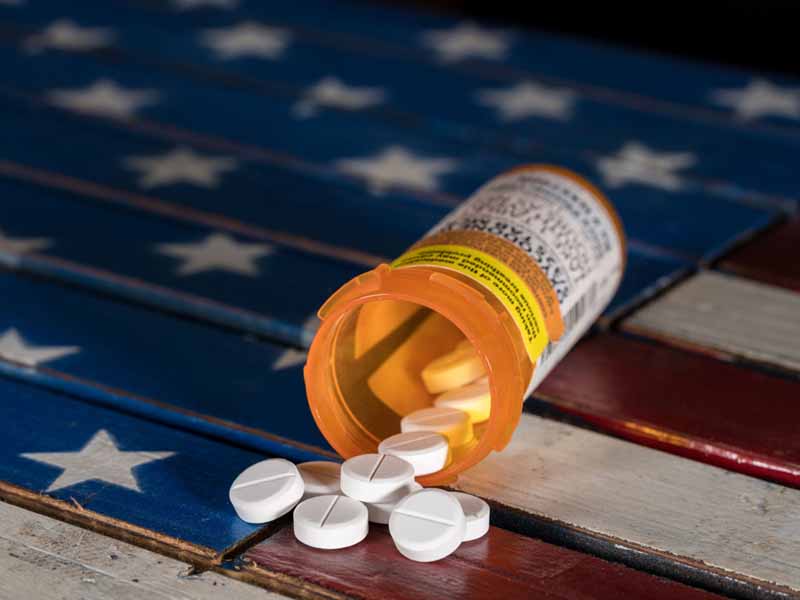Study Finds 22 Percent Decrease in Opioid Prescriptions
AAFP/AMA Release Medication-assisted Treatment Advocacy Resource
April 25, 2018, 12:15 pm News Staff – Opioid prescriptions in the United States decreased 22 percent between 2013 and 2017.
This is according to a new study from the IQVIA Institute for Human Data Science titled, "Medicine Use and Spending in the U.S.: A Review of 2017 and Outlook to 2022."
"A 22 percent decrease in opioid prescriptions nationally between 2013 and 2017 reflects the fact that physicians and other health care professionals are increasingly judicious when prescribing opioids," said Patrice Harris, M.D., M.A., chair of the AMA Opioid Task Force in an April 19 news release.
Additional Report Details
The IQVIA report found prescription opioid dosage volume -- measured in morphine milligram equivalents (MME) -- decreased 12 percent in 2017, which was the biggest annual drop in more than 25 years, according to an IQVIA news release.

Previously, prescription opioid volume had increased each year since 1992, peaking in 2011. But the report said this trend was reversed due to a combination of regulatory and legislative restrictions, tighter clinical prescribing guidelines and greater reimbursement controls, which all resulted in decreases of about 4 percent per year from 2012-2016.
In more good news, the annual decrease in prescription opioid volume during the past five years occurred in all 50 states.
"It is notable that every state has experienced a decrease, but this is tempered by the fact that deaths related to heroin and illicit fentanyl are increasing at a staggering rate, and deaths related to prescription opioids also continue to rise," Harris said.
The study found that in addition to decreases in MME prescribed, dispensed opioid prescriptions also dropped more than 10 percent in 2017. High doses of opioids, prescribed to patients at more than 90 MME/day and associated with higher risk of dependency and overdoses, declined by more than 16 percent the same year.
Story Highlights
Harris said the study's findings bolster the argument that solely decreasing the prescription opioid supply won't end the ongoing epidemic.
"We need well-designed initiatives that bring together public and private insurers, policymakers, public health infrastructure and communities with the shared goal to improve access and coverage for comprehensive pain management and treatment for substance use disorders," she said.
Furthermore, Harris said the IQVIA report signaled progress in boosting the use of medication-assisted treatment (MAT) for patients with opioid use disorder -- nearly doubling new treatment starts from 44,000 in December 2015 to 82,000 in December 2017.
"This evidence-based treatment can slow and even stop this epidemic," Harris said. "Physicians and other stakeholders accept that bold action is needed. We go where the evidence leads us. We all must take care that policies and practices don't restrict access to one alternative for pain relief without increasing access to comprehensive, multidisciplinary pain care, including non-opioid-based options."
AAFP/AMA MAT Resource
In 2015, the AMA launched its Opioid Task Force, to which the AAFP belongs, to identify best practices for combatting opioid abuse and to swiftly implement these practices in offices across the United States.
The task force's work has included partnering with state medical societies to address legislation and regulation ranging from developing effective prescription drug monitoring programs, continuing medical education, restrictions on treatment for opioid use disorder, and enactment of naloxone access and good Samaritan overdose protections.
As with the Opioid Task Force, the AAFP and the AMA have worked together to create a new resource advocating for the use of MAT for patients with opioid use disorder that family physicians can use.
MAT helps decrease overdose deaths and reduce the transmission of infectious diseases, including HIV and hepatitis C. FDA-approved MAT for opioid use disorder includes buprenorphine, naltrexone and methadone.
The joint resource cited a fact sheet on MAT from The Pew Charitable Trusts that showed patients who use medications to treat their opioid use disorder remain in therapy longer than people who don't and are less likely to use illicit opioids.
Additionally, the resource noted that several major national insurers, including Aetna, Cigna and Empire Blue Cross, said their health care plans will no longer require prior authorization for MAT.
The resource also makes the case that, in general, use of MAT saves money. An analysis of the impact of MAT on Medicaid expenditures and health services rates in Vermont found that this treatment for Medicaid beneficiaries with opioid addiction was associated with reduced general health care expenditures and utilization, including hospital admissions and outpatient emergency department visits.
"We urge family physicians to become certified in providing medication-assisted treatment," AAFP President Michael Munger, M.D., of Overland Park, Kan., said in the resource. "Family physicians are uniquely qualified to meet the medication management and whole-person care that MAT requires.
"But in order to expand access to MAT, we must have universal policies that end barriers such as prior authorizations that delay or can essentially deny care for those who need it most."
Related AAFP News Coverage
AAFP 2018 Residency Education Symposium
Residency Leaders Encourage Training in Opioid Prescribing
(4/3/2018)
New CDC Reports
Emergency Departments See Opioid Overdoses Skyrocket
(3/9/2018)